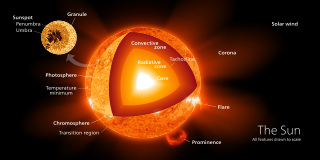
Back Sonwind Afrikaans Aire solar AN ريح شمسية Arabic Vientu solar AST Günəş küləyi Azerbaijani Сонечны вецер Byelorussian Сонечны вецер BE-X-OLD Слънчев вятър Bulgarian सौर हवा Bihari Sunčev vjetar BS


The solar wind is a stream of charged particles released from the Sun's outermost atmospheric layer, the corona. This plasma mostly consists of electrons, protons and alpha particles with kinetic energy between 0.5 and 10 keV. The composition of the solar wind plasma also includes a mixture of particle species found in the solar plasma: trace amounts of heavy ions and atomic nuclei of elements such as carbon, nitrogen, oxygen, neon, magnesium, silicon, sulfur, and iron. There are also rarer traces of some other nuclei and isotopes such as phosphorus, titanium, chromium, and nickel's isotopes 58Ni, 60Ni, and 62Ni.[2] Superimposed with the solar-wind plasma is the interplanetary magnetic field.[3] The solar wind varies in density, temperature and speed over time and over solar latitude and longitude. Its particles can escape the Sun's gravity because of their high energy resulting from the high temperature of the corona, which in turn is a result of the coronal magnetic field. The boundary separating the corona from the solar wind is called the Alfvén surface.
At a distance of more than a few solar radii from the Sun, the solar wind reaches speeds of 250–750 km/s and is supersonic,[4] meaning it moves faster than the speed of fast magnetosonic waves. The flow of the solar wind is no longer supersonic at the termination shock. Other related phenomena include the aurora (northern and southern lights), comet tails that always point away from the Sun, and geomagnetic storms that can change the direction of magnetic field lines.
- ^ McComas, D. J.; Elliott, H. A.; Schwadron, N. A.; Gosling, J. T.; Skoug, R. M.; Goldstein, B. E. (2003-05-15). "The three-dimensional solar wind around solar maximum". Geophysical Research Letters. 30 (10): 1517. Bibcode:2003GeoRL..30.1517M. doi:10.1029/2003GL017136. ISSN 1944-8007.
- ^ "Stanford SOLAR Center – Ask A Solar Physicist FAQs – Answer". solar-center.stanford.edu. Retrieved 2019-11-09.
- ^ Owens, Mathew J.; Forsyth, Robert J. (2013-11-28). "The Heliospheric Magnetic Field". Living Reviews in Solar Physics. 10 (1): 5. arXiv:1002.2934. Bibcode:2013LRSP...10....5O. doi:10.12942/lrsp-2013-5. ISSN 2367-3648. S2CID 122870891.
- ^ McGRAW-HILL ENCYCLOPEDIA OF Science & Technology, 8th ed., (c)1997, vol. 16, page 685